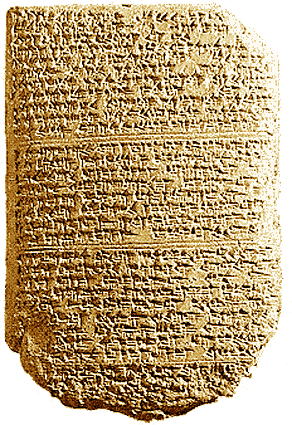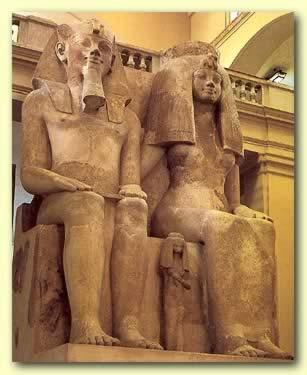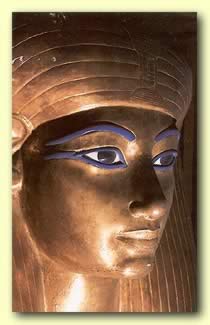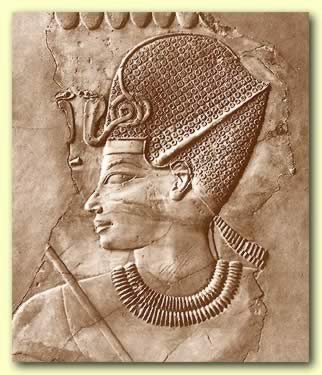UP
 Ancient
Temple Ritual
Ancient
Temple Ritual  Hieroglyphics
101
Hieroglyphics
101
 Translation
Translation
Gardiner sign list
 Spoken Egyptian in the 18th dynasty:
Dictionary
Spoken Egyptian in the 18th dynasty:
Dictionary
Ah-mane-ha-tee-pee III of Egypt
& his Babylonian consort Telika-Ventiu
(c.1402 - 1364 BC)

- The information on many of Floating-world's Egyptian pages purport to be a first hand account of life 3400 years ago, as gathered through a medium.
This remarkable historical account was reported by Dr. Frederic H. Wood in several books(1).
A young Englishwoman, speaking in partial trance as "Nona", sprinkled her account (given in English) with ancient Egyptian phrases. ... The xenoglossy (her ability to speak accurately in a language that her conscious mind did not recognize) provides strong evidence that the capacity once possessed by some person to converse extensively, purposefully, intelligently, and intelligibly in the Egyptian language of three thousand years ago, or anyway in a language closely related to it, has survived by many centuries the death of that person's body(9).
So on with what she had to say.....
Telika-Ventiu, the almost forgotten wife of Amunhotep III, had a great mistrust of the priests of Egypt. They wound up murdering her, perhaps, as Vandenberg suggests, being the reason when her brother's envoys came to have a look at his sister, nobody in the harem looked familiar to them. There is a translation of her brother's letter, below, bewailing the fact that she disappeared.
The pre-arranged "accident" occurred when Telika and a girlfriend, Vola, were out in a boat. Vola's father the Syrian king, had been killed by the Egyptians. Given to Telika, Telika adopted & befriended the civilized girl, both being foreigners in Egypt. Telika found satisfying work for Vola as a temple maiden. Telika had considerable influence, it seems, and was respected by Amenhotep for her mind. She used her influence with him in favor of the New Religion which Akh-en-aten, his son adopted in the next reign. As such, she was a threat to the traditionalist priests and his first wife Tiy that whose power depended on the status quo. Telika is quoted as saying to our age:
"Our wise men in Egypt had knowledge that would be prized today, could it be recaptured. They understood the elements better than your scientists today. The ancient adepts could use and harness electricity from the air. We in Egypt used chemicals for lighting, not electricity, which we could not harness as you do."
Of her husband she tells Wood,
"He was a much finer soul than the historic records show. It was through suffering that his mind turned away from temporal things, in those later years of ill-health, to what I was able to tell him about the New Religion."
Her account of the New Religion (worship of Amoon):
It broke away from elaborate ritual and sacrifices to gods, and substituted a simple form of worship of the Supreme God. It differed from Christianity in that it did not deny the gods worshipped in Egypt; but since there was one Great God in the universe- even the orthodox Egyptians believed that, though they held He could not be directly approached- the New Religion held that He could be so approached.
It encouraged spontaneous prayer. The older priests did not. They had their own set prayers, and people were expected to use them. This new faith was a natural, spiritual protest against the empty forms of worship used in the temples. The essential Truth will always fight against an over-elaborate and priest-ridden form of worship.
The New Religion was not born in Egypt. It came from a land farther east, and was born in one of the solitary places where earnest souls gather together. Some told us that a Saviour or Messiah had come to proclaim this faith, but the world was not ready for it. No spiritual truth can take root until the people are ready to receive it." - Rosemary Records. May 16th, 1936
Of the Queen, the temple maiden Vola says:
The Babylonian wife in Egypt was a turbulent soul, even then. She was more like a man than a woman. She had talked with, and met people who followed the New Religion. The priests feared her power over the Pharaoh, for she had considerable influence with him. He was a weary man then, and found comfort in what she told him. He was tired of the glamour of the old religion. I was only young, but I loved her. She had been so kind to me. She adopted me, and made me officially her child. Thus I became a naturalized Egyptian. Being a queen, she had certain rights which even the Pharaoh could not abrogate. I became a temple-virgin, and the reason I was drowned with the Queen was that they did not know how much I knew of their plotting. The Queen was a dangerous enemy. She was an austere soul, and did not like the Egyptians.
...She had a strong, austere, remote personality even then. She had a mind more like that of a man than of a woman. She often came to talk with me, and knew that I could be trusted to keep my own counsel. She hated the Court etiquette, and was for that reason hated by the queen, who feared her. Everything at the Court was formal. One had always to be attended by slaves, to stand in this way or sit in that way. She hated it all, and it was her influence with the pharaoh that was feared by the queen and by the priests." - Rosemary Records. May 16th, 1936
The Amarna Tablet
Dr. Wood mentions that a clay tablet found at Tell el-Amarna in 1887 is generally accepted as evidence that Amenhotep III had married a Babylonian princess(5). Her name, however, appears nowhere; so that, should a papyrus eventually be found giving it as Telika Vendu, this would be strongly confirmatory evidence. Nona, when she added the "Ventiu" insisted that it was or would be important as evidence (TEM 49-51, AES 37).
< A clay tablet recording the king's letter set by the then Babylonian king to the Pharaoh Amenhotep III after the murder:
" Behold, thou desirest my daughter for thyself in marriage, while my sister, that my father gave thee, is there with thee: and nobody now has seen her, whether she be living or dead."
- translation by J. A. Knudtzon and C. J. GaddThis remains the only reference to her life in Egyptian records.
|
|
MEAN QUEEN
After her death, The kings other wife Tiy erased all historical documents that referenced her rival wife Telika, and may have played a role in her murder. She looks pretty mean here, don't you think? That may just be her "game face." Her husband rarely smiled at formal occasions. "When he went in state to the Temple his face was always like a mask. He was always on his dignity, and very much the ruler." (2)
Tiy was not of royal blood, but came from a very substantial family. She was Tiy, the daughter of Yuya and his wife, Tuya, who owned vast holdings in the Delta. Yuya was also a powerful military leader. It is possible that the king's early regency was carried out by his wife's family.
Of her, Telika says:
The queen was obsessed by a wish to dominate. She was afraid of the New Religion. She hated anything new, and clung to the old rituals. Even in the court she would have no new ideas. She was determined to be prominent, and unpleasant to be with; a domineering woman with a strong physical aura which left one tired and drained of all strength. Even the Pharaoh felt that. I still maintain that had the power of the queen been removed, and had the young Ak-he-na-ten been surrounded by sympathisers, the further history of Eygpt would have been different : neither do I think the Empire would have fallen. He has been blamed too much for that. He was wise, clever, mild and gentle, and he lacked courage; but he stood alone.
Nona states that she expresses herself by impressing her thoughts on Rosemary's mind, which then spontaneously formulates them in English either orally or in writing. But Nona, in the course of the many years' sittings, has given out orally some 5000 phrases and short sentences in old Egyptian language. In the case of these, Rosemary states that she "hears" the Egyptian words clairaudiently and repeats them aloud-this having first occurred on August 18, 1931 (TEM 171). As she utters them, Dr. Wood records them phonetically as well as he can in terms of the English alphabet.
It is unfortunate
that he was not then familiar with, and therefore did
not use, the more adequate alphabet of the International
Phonetic Association; but his recording was anyway good
enough to enable an Egyptologist, Mr. Hulme, to identify
with but a correction here and there, and to translate
the first eight hundred of these thousands of Egyptian
utterances, which constitute coherent communications
manifesting purpose, intelligence, and responsiveness to
the conversational situation of the moment. Dr. Wood, in
order to qualify himself to meet certain criticisms by
Prof. Battiscombe Gunn of Oxford University, then (1937)
took up the study of scholastic Egyptian and eventually
became able to translate himself the word sounds, which
previously he could only record without understanding
them.
In the course of the many years of sittings with Dr.
Wood. Rosemary has developed ostensible memories,
extensive and detailed, of a life of hers in Egypt as "Vola,"
a Syrian girl brought captive to Egypt, whom Nona
befriended (AES Chs. VIII, IX.).
So much being now clear about the ostensible situation
and process of communication in the Rosemary case,
attention must next be directed to the fact in it which
is of central interest in connection with the topic of
the present chapter. That fact is Nola's assertion that
Rosemary was with her in Egypt, her name then having
been Vola; so that Rosemary would be a reincarnation
of Vola. Nona states further-although this is not
essential to the point-that Vola was the daughter of a
Syrian king killed in battle with the Egyptians; that
she was brought to Egypt as a captive and given to Nona
who liked and adopted her, and had her appointed a
temple maiden in the temple of Amen Ra; and that the
enemies of Amenhotep Ill, who were plotting to wrest the
power from him and were afraid of Nona's influence on
him, contrived an accident in which she and Vola drowned
together.
In this complex affair the most arresting fact, which
has to be somehow explained, is the utterance by
Rosemary's lips of those thousands of phrases in a
language of which she normally knows nothing, but
concerning which Mr. Hulme, an Egyptologist, states
that, in the eight hundred of them he had examined, the
grammar and the consonants substantially and
consistently conformed to what Egyptologists know today
of the ancient Egyptian language.
The phrases as uttered supply vowel sounds, which are
otherwise still unknown since the hieroglyphs represent
only the consonants(6). There is today no way of either
proving or disproving that these vowel sounds are really
those of the ancient speech, although a presumption in
favor of it arises from the consistency of their use
throughout those thousands of phrases, and from the
substantial correctness of the xenoglossy as regards
grammar and consonants. But in any case, the Rosemary
affair remains the most puzzling and yet the best
attested instance of xenoglossy on record.
- Read the full essay by Curt J. Ducasse
How do Hieroglyphs sound when spoken?
|
Historical Notes
Having inherited an empire which stretched from the Euphrates to the Sudan, Amenhotep III maintained Egypt's position largely through diplomacy and intermarriage with the royal families of Mitanni /Syria, Babylonia (queen Telika-Ventiu) and Arzawa /Anatolia.
At the imperial capital Thebes, the king's sprawling palace at Malkata lay close to his funerary temple, the largest ever built and its original location marked by the two 'Colossi of Memnon' statues. A vast harbour and canal network linked these buildings to the river Nile and allowed direct access to the king's new temple at Luxor and the great state temple of Amun at Karnak.
Although Amenhotep greatly embellished Karnak as part of his nationwide building programme, the growing power of Amun's clergy was skillfully countered by promoting the ancient sun god Ra. The sun was also worshipped as the solar disc the Aten, with whom the king identified himself by taking the epithet 'Dazzling Aten'.
In the last decade of his reign Amenhotep III celebrated an unprecedented three jubilee festivals whose protocol had been carefully researched by the king's scribes. The discovery of royal bookplates and fragments of artifacts already 1500 years old also hints at the king's 'antiquarian interests'.
Following his death around the age of 50, Amenhotep III was buried in his huge tomb in the secluded western branch of the Valley of the Kings, and was succeeded by his surviving son Amenhotep IV, better known as Akhenaten, the 'heretic king'.
Although Amenhotep III has long been overshadowed by his infamous son, it is clear that many of the innovations attributed to Akhenaten, including the popularization of the Aten and more expressive art and literary styles actually began in the reign of Amenhotep III, the true instigator of the so-called 'Amarna Period'.
|




 many other statues give the king a look of reflection,
and bringing to life emotional emphasis. We find grand
statues of black granite depicting a seated Amenhotep
wearing the nemes headdress, unearthed by
many other statues give the king a look of reflection,
and bringing to life emotional emphasis. We find grand
statues of black granite depicting a seated Amenhotep
wearing the nemes headdress, unearthed by
 red granite head found by Belzoni and initially
identified as representing Tuthmosis III, his statues
were more extensively reworked (this example by
red granite head found by Belzoni and initially
identified as representing Tuthmosis III, his statues
were more extensively reworked (this example by